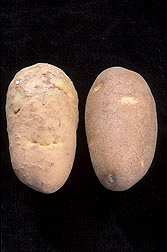Scientists Use Old, New Tools To Develop Pest-Resistant Potato
|
|
Despite their microscopic size, Columbia root-knot nematodes (CRN) have potential to inflict huge losses—about $40 million annually—by tunneling into potatoes to feed. But this level of loss isn’t likely to happen, thanks to fumigants growers now use—at a cost of $20 million annually.
In seeking alternatives to using chemical fumigants, ARS and collaborating scientists are field-testing a new russet potato breeding line that naturally resists the pests.
Commercial varieties bred from line PA99N82-4 would be the first with resistance not only to CRN, but also to northern and southern root-knot nematodes, says geneticist Chuck Brown. He’s in ARS’s Vegetable and Forage Crops Research Unit at Prosser, Washington. “PA99N82-4 also resists the viral disease corky ringspot, which is transmitted by nematodes and causes unsightly blemishes in tubers,” he adds. “Corky ringspot is also controlled by soil fumigation.”
CRN is problematic in the Pacific Northwest, where two-thirds of America’s potatoes are grown, and in Florida. Though fumigating the soil before planting suppresses CRN numbers, the practice isn’t cheap, with some chemicals costing $300 per acre. It can also harm nontarget organisms, including beneficial soil-dwelling insects.
Genetic resistance, however, confines the fight to the potato’s roots and tubers. But putting that resistance to work hasn’t been easy.
Because resistance is absent from U.S. cultivated potatoes, Brown and colleagues used the wild species collection at ARS’s U.S. Potato Genebank in Sturgeon Bay, Wisconsin. Painstaking screening of the material at Prosser showed Solanum bulbocastanum to be the most resistant.
The problem is, wild and cultivated potatoes are chromosomally incompatible. So the researchers resorted to “bridging,” a technique that fused S. bulbocastanum and cultivated potato cells together, forcing the DNA of both to combine. Stimulants were then added to induce cells to become plantlets. Over several years, the researchers used backcrossing to eliminate unwanted traits—like tiny tubers and poor taste—from resistant plants they had created.
Besides conventional plant-breeding techniques, they used biotechnology methods, including DNA markers linked to S. bulbocastanum’s gene for resistance, RMc1(blb). Normally, resistance levels are determined by inoculating potted plants with nematodes, waiting 7 weeks, and removing and washing the roots so the pests’ eggs can be counted.
“It’s a laborious, time-consuming process,” says Brown. But with marker technology, leaf tissue can be quickly analyzed for genetic evidence of RMc1(blb). “Being able to determine in 1 day’s time which plants are resistant is very helpful,” he adds.
Still, the entire process to date has taken 20 years and the close collaboration of many scientists, including ARS postdoctoral researcher Lin-Hai Zhang, at Prosser; Washington State University scientist Hassan Mojtahedi; and John Helgersen, now retired from ARS.
PA99N82-4, the top pick of this intensive effort, is in its third year of field trials. Besides tests in Washington, Oregon, and Idaho under the Tri-State Potato Breeding Program, it’s also being evaluated in California and Texas. Two more years of testing will follow before the line is released for development into commercial varieties.—By Jan Suszkiw, Agricultural Research Service Information Staff.
This research is part of Plant Biological and Molecular Processes, an ARS national program (#302) described on the World Wide Web at www.nps.ars.usda.gov.
Charles R. Brown is in the USDA-ARS Vegetable and Forage Crops Research Unit, 24106 N. Bunn Rd., Prosser, WA 99350; phone (509) 786-9252, fax (509) 786-9277.
"Scientists Use Old, New Tools To Develop Pest-Resistant Potato" was published in the April 2009 issue of Agricultural Research magazine.







